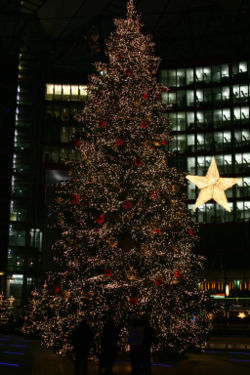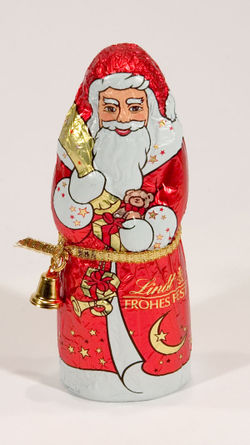
German Christmas traditions have inspired Christmas celebrations around the world, particularly in the United States.
Contents |
Introduction
German Christmas traditions include the customs, folklore, history, family practices, and religious and secular symbols associated with this holiday. The Christmas season in Germany starts at the beginning of Advent, which is four Sundays before Christmas Day. In fact, Advent wreaths are one of the many symbolic German Christmas traditions. These wreaths are decorated with four candles around the outer circle and with one large candle in the middle. The four outer candles symbolize the 4,000 years that the world had to wait for Christ's coming. One candle is lit the first Sunday of Advent with two being lit the second Sunday and so on. The large candle in the center is lit on Christmas Day.
Tannenbaum
The Tannenbaum, or Christmas tree, has its roots in pre-Christian Germany. Religious rites were held in the forests and trees were decorated with candles. Like the Druids, the oak was sacred to the ancient Germans, in particular to the god Odin, so it was often the oaks that were lit and not the pines. The use of evergreens can be traced back to the 8th century, which is when St. Boniface engaged in the common practice of adopting local pagan customs to help Christianize the indigenous peoples. He substituted the fir tree (Tannenbaum) for the oak of Odin and then he dedicated it to Christ, making it the Christbaum.
The creation of the modern Christmas tree is often attributed to the founder of the Lutheran movement, Martin Luther (1483-1546). This is questionable but there are "Tannenbaum" songs that date back to the middle of the 16th century. By the 19th century the Christmas tree had become popular in Europe and America, having been introduced by German immigrants.
Candles, of course, were the original source of light on Christmas trees and although the Germans, Austrians, and Swiss are increasingly using electric lights on their trees, many a Christbaum is still lit with candles.
There is a Bavarian Christmas tree tradition that is known as the "Brides Tree." This is where 12 ornaments are hung upon a tree to help bring good fortune to a newly married couple. The 12 ornaments symbolize the following: angel (God's guidance), bird (joy), fish (Christ's blessing), flower basket (good wishes), fruit basket (generosity), heart (true love), house (protection), pine cone (fruitfulness), rabbit (hope), rose (affection), Santa (goodwill), and teapot (hospitality).
St. Nicholas

The Christmas tree is not the only familiar Christmas symbol that comes from Germany. Santa Claus also had his origins there. When Germany was being Christianized in the early Middle Ages, St. Nicholas, a 4th century bishop of Asia Minor, became popular there. St. Nicholas is the patron saint of children and his feast day is December 6th. Gradually a custom grew up where on the eve of St. Nicholas' feast day children would place their shoes or boots out for St. Nicholas to fill with candy and fruit, with the bad children getting twigs. St. Nicholas carried with him a book of sins with which he determined whether the child warranted the goodies or the twigs. Historically, St. Nicholas rode a white horse and he traveled with a dark-faced companion. The most common one was called Knecht Ruprecht. After the Protestant Reformation in Germany, German authorities wanted to do away with the image of a Catholic saint distributing gifts, so the idea of Santa Claus was born. Also created were the white beard, red suit, and sleigh. St. Nicholas is known by several names in different parts of Germany. These include Klaasbuur, Rauklas, Bullerklaas, and Sunnercla. In the eastern part of Germany, he is Ash Man, Shaggy Goat, or Rider. The name Kris Kringle is a corruption of the German term Christkindl ("Christ Child"). Saint Nicholas is now known primarily in Germany as Weihnachtsmann or Father Christmas. He increasingly doesn't appear any longer on December 6th but on Christmas Eve instead.
Food and drink
Food and drink play a major role in the German Christmas celebration. In cities throughout Germany there are Christkindlesmarkts. In these Christmas markets one can enjoy all types of delicious Christmas edibles and beverages. Christmas goodies, from Lebkuchen (gingerbread) to Weihnachts Stollen (fruit bread) are plentiful. And the aroma of Glühwein ("glow wine"), a hot mulled wine that is drunk by adults and older children alike, fills the air. On Christmas Day many German families sit down and enjoy a plump roast goose for dinner.
Three Magi
January 6th is the day the three Magi came to visit the Christ Child. This is a holiday in Germany and it marks the end of the month and a half long Christmas celebration.
Sources
- Hal Siemer (2006). O Tannenbaum: Many American Christmas Traditions Are German. Quest Magazine. Retrieved Sep. 28, 2006.
See also
Categories: Christmas traditions
